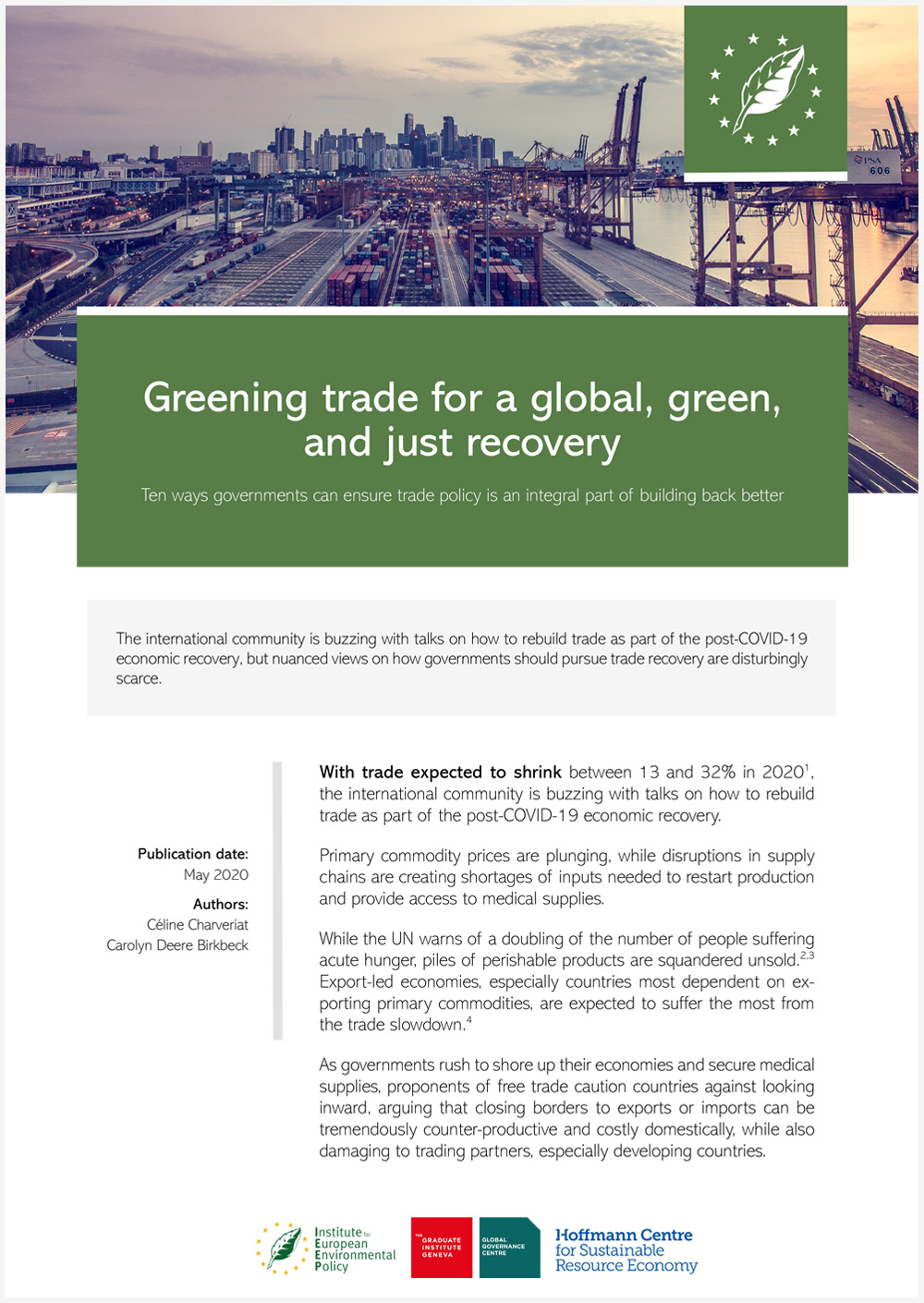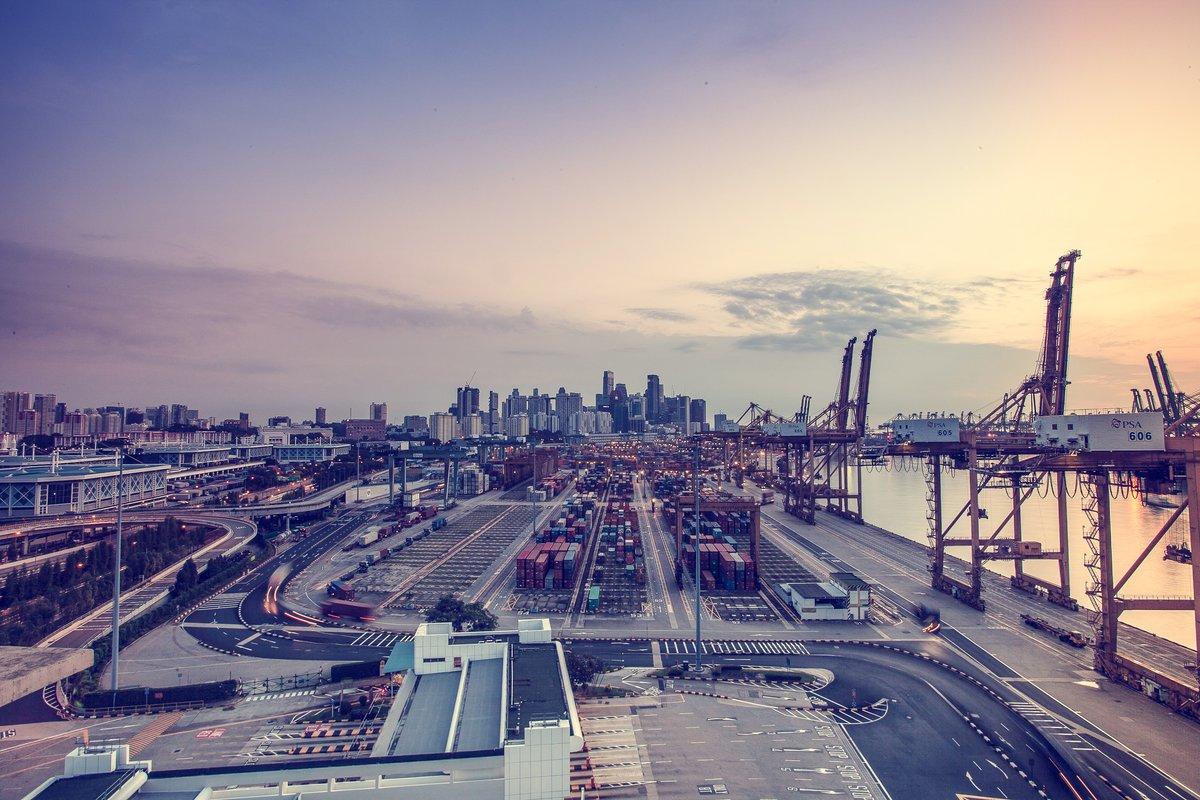Authors: Céline Charveriat, Carolyn Deere Birkbeck
The international community is buzzing with talks on how to rebuild trade as part of the post-COVID-19 economic recovery, but nuanced views on how governments should pursue trade recovery are disturbingly scarce. Here are ten ways governments can ensure trade policy is an integral part of building back better.
With trade expected to shrink between 13 and 32% in 2020, the international community is buzzing with talks on how to re-build trade as part of the post-COVID-19 economic recovery.
Primary commodity prices are plunging, while disruptions in supply chains are creating shortages of inputs needed to restart production and provide access to medical supplies.
 Ten ways governments can ensure trade policy is an integral part of building back better (PDF 226 KB) Ten ways governments can ensure trade policy is an integral part of building back better (PDF 226 KB) |
While the UN warns of a doubling of the number of people suffering acute hunger, piles of perishable products are squandered unsold. Export-led economies, especially countries most dependent on exporting primary commodities, are expected to suffer the most from the trade slowdown.
As governments rush to shore up their economies and secure medical supplies, proponents of free trade caution countries against looking inward, arguing that closing borders to exports or imports can be tremendously counter-productive and costly domestically, while also damaging to trading partners, especially developing countries.
Other voices are promoting a new discourse of “deglobalisation”, presenting relocalisation, shorter supply chains and self-sufficiency as inevitable and desirable consequences of the pandemic, and ones that could support fairer social and better environmental outcomes.
Between these two perspectives, nuanced views on how governments should pursue trade recovery are disturbingly scarce.
Worse, there has so far been little attention to how trade and trade policy can support a green and just recovery, aligned with the Sustainable Development Goals and with the aim of “building back better”.
For the global environment, the COVID-19-induced economic downturn and related impacts on global trade have important implications and contradictions. Reduced economic activity, including in key industrial sectors, can lower the pressures on the environment. We’ve seen this in the combined COVID-19 effects of lockdowns, declining international trade, and restrictions on international transportation that have notably reduced greenhouse gas emissions and air pollution from air, sea and road travel.
A further enduring impact might be a widening retreat from environmental regulations in key trading nations. Indeed, some governments have already rolled back environmental regulations during the COVID crisis, and the trend could get worse as environmental requirements are deemed too costly amidst the scramble to revive businesses and secure competitive advantage.
| The risk is that we lose momentum towards less carbon-intensive goods and services, more sustainable production and consumption |
If the crisis response by governments and companies focuses back on the “basics”, the risk is that we lose momentum, however tentative, towards less carbon-intensive goods and services, more sustainable production and consumption, and the diffusion of more sustainable technologies.
The growing push to align trade with the Paris climate ambitions might fall down the agenda of governments preoccupied with boosting short-term growth and employment.
The economic landscape has shifted massively – in ways that few would have imagined – including in sectors critical to international trade, like aviation and shipping, carbon-intensive sectors, like fossil fuel industry, and tourism.
Amidst the debate on how profound and long-lasting their impacts will be on global trade patterns, the challenge is to see how governments can use trade policy strategically in the context of economic recovery to rebuild in ways that make international trade in goods and services – and associated international transportation – more environmentally sustainable.
Here, there is a growing chorus of voices calling to build a fairer and more sustainable economy. Their unifying point is that recovery plans should help societies build back better than before – supporting, for instance, those businesses and business models that can help boost the environmental sustainability of our economies and bolster their resilient in the face of existing and emerging environmental threats.
However, we still lack voices pointing to the important interlinkages between a green recovery and trade, and the relevance and role of international trade policy.
The European Trade Commissioner has spoken out, for instance, on the importance of rebuilding trade – and on cooperation so that trade policies facilitate access to urgently needed medical supplies – but to date, there has been no mention of environmental sustainability, the European Green Deal or the SDGs.
More broadly, while the G20 has called for maintaining support for an open trade system as part of economic response to the pandemic crisis, many of the recovery plans supported by governments are underpinned by massively trade-distorting and environmentally-harmful government subsidies and risk including an array of trade defence measures intended to protect carbon-intensive sectors.
In recent weeks, the efforts by governments to cooperate on trade policies to ensure access to medical supplies have been far from perfect, but they have provided a refreshing signal that trade policy and trade can and should be harnessed for specific ends – to deliver on public policy objectives and respond to global challenges. This is something the environment-trade agenda and community can build on.
| The point is not to be for free trade as an end in itself, nor to be against open trade per se |
The point is not to be for free trade as an end in itself, nor to be against open trade per se – but to ensure that trade and trade policy are an integral part of our efforts to build a fairer and more sustainable global economy.
A forward-looking trade policy agenda must also seek to build strategic alliances between developed and developing countries, with the diversity of constituencies in civil society and private sector in favour of a just and green recovery.
Here are 10 ways that governments could ensure that trade policy is rightly an integral part of wider policy efforts to build back better through green and just economic recovery:
- Adopt a Green Trade for Green Recovery initiative at the G20, which puts the furthest behind first. This would focus on ensuring rapid recovery of sustainable sectors (such as sustainable tourism), addressing green capacity constraints through access to trade finance, relax rules of origin for low-carbon sectors and products, boosting green aid for trade and promoting green technology transfer for low-income countries.
- Ensure evidence-based and cooperative approaches to building green, resilient and transparent supply chains which support quality employment and natural environmental capital protection of low-income countries while strengthening the climate resilience of trade infrastructure in developing countries.
- Adopt collaborative and inclusive approaches to the design and use of product and production standards for circularity and decarbonisation within key global supply chains.
- Engage in constructive dialogues around trade-related aspects of the gradual phase-out of the “brown” economy. This requires disciplining subsidies and investment that create long-term trade- and competition-distorting effects alongside negative climate impacts, especially those related to fossil fuels; avoiding trade defence measures which have the same impact; and providing targeted support for structural reform in low and medium-income countries to eliminate fossil fuel subsidies.
- Promote coordinated trade policy response to COVID-related food security challenges in line with Policy Coherence for Sustainable Development principles (PCSD) and the overarching goal of supporting regenerative, environmentally sustainable agriculture and food systems.
- Take action on new approaches and models for bilateral and regional trade and investment agreements that respond to urgent Covid-19 related challenges in ways that also catalyse and promote the transition toward a more circular and net-zero global economy, ensure countries have space to implement the Paris Agreement, support adaptation to climate change and advance the achievement of the SDGs.
New negotiations for a plurilateral Agreement on Climate Change, Trade and Sustainability (ACCTS) show the potential for new thinking and approaches, which could be championed through initiatives such as the Friends of Advancing Sustainable Trade (FAST). - Create an independent, interdisciplinary panel appointed by the WTO Director-General on how to ensure WTO negotiations – both multilateral and plurilateral negotiations, such as those on investment facilitation and e-commerce – contribute to the implementation of the SDGs and Paris Agreement.
- Support an ambitious trade and environmental sustainability Ministerial Statement at the 2021 WTO Ministerial, ramping up action by governments and stakeholders on challenges and opportunities related to trade and environmental sustainability, in ways that build cooperation between developed and developing countries and advance progress on the SDGs.
- Finalise a fair and meaningful WTO agreement on fishery subsidies that ad-dresses the impact of the current crisis on employment within the sector and food security of populations dependent on fish for their access to protein.
- Enhance high-level political leadership in favour of problem-solving, dialogue and evidence-building on trade and environmental sustainability, especially on those issues already identified as a broad interest to both developed and developing countries. One issue ripe for attention is how trade and trade policy can be used to tackle pollution from the plastics sector and support transformation to more sustainable and circular alternatives.


